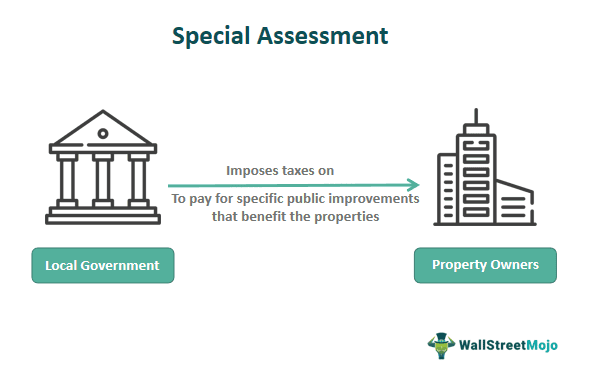Table Of Contents
What Is Special Assessment?
A special assessment is a type of tax levied by a local government on property owners to pay for specific public improvements or services that benefit the property. These assessments are typically used to finance public projects like street improvements, sidewalks, and other infrastructure projects that directly benefit the property owners in the area.

A special assessment provision ensures that property owners who benefit from a public improvement or service pay a fair share of the costs associated with it rather than the cost is borne entirely by the general public. The assessment amount is typically based on the size of the property, the nature of the improvement, and the project's estimated cost.
Key Takeaways
- The special assessment is a tax that a government or homeowners' association imposes on property owners for a specific purpose, such as public infrastructure improvements or repairs in a particular area.
- Unlike regular property taxes, they are not for general government operations but rather for a specific purpose.
- The amount of a special assessment can vary based on several factors, including the cost of the project, the number of properties affected, and the assessed value of the properties.
- They are often used with other funding sources, such as grants or bonds, to finance public infrastructure projects or improvements.
Special Assessment Tax Explained
A special assessment is a targeted property tax assessed on a specific group of properties to fund the cost of public infrastructure improvements that directly benefit those properties. Its history can be traced back to ancient times when governments would impose taxes on specific groups of people or properties to fund public projects.
In the United States, the practice of special assessment dates back to the mid-19th century. At that time, cities and towns began to use this method to fund the construction of public utilities like water and sewer systems. Over time, the practice became more widespread, particularly in the early 20th century. This was due to the growth of cities and towns and the increased demand for public infrastructure.
In the early days of the special assessment, property owners often had to pay the full cost of the improvements upfront or in installments, which could be a significant financial burden. However, the practice has become more refined over time, and governments have developed various methods to make special assessments more manageable for property owners.
Many local governments across the United States use a special assessment today to fund a wide range of public projects. The practice has become an essential tool for financing public infrastructure improvements and is an important part of local government finance.
Examples
Let us look at some examples to understand the concept better:
Example #1
Imagine living in a neighborhood prone to flooding during heavy rainfall. The local government has decided to improve the drainage system in your area to prevent this issue from occurring. The estimated cost of the project is $1 million. After conducting a study, the government has determined that the properties most likely to be affected by flooding will benefit the most from the improvement.
To finance the project, the local government has decided to impose a special assessment on the properties that will benefit the most. It is calculated based on the estimated benefit to each property, and the total assessment amount is $500,000.
The government has notified the affected property owners of the special assessment and has set the payment terms at ten annual installments of $50,000 each. Property owners can pay the entire assessment upfront or in installments, giving them the flexibility to manage their finances.
Once the assessment is paid, the revenue generated is used to finance the drainage improvement project. The government oversees the project to ensure efficient and effective project completion. After the project is finished, the local government is responsible for maintaining the new drainage system to ensure it continues functioning properly and benefits the community for years.
Example #2
San Francisco, California's sidewalk assessment program is a great example of how special assessments can finance specific public improvements or infrastructure projects. The program, implemented in 2016, enables property owners to request sidewalk repairs and replacements through a special assessment district.
Under this program, the city calculates sidewalk repair costs and divides them among the affected property owners based on their linear frontage. Also, the property owners can pay the assessment in a lump sum or installments over 20 years.
This special assessment program has successfully addressed the city's sidewalk repairs and improvements backlog. Additionally, it empowers property owners to take a proactive approach to sidewalk maintenance, ensuring that the sidewalks in their community are safe and well-maintained.
Special Assessment vs Loss Assessment vs Mello-Roos
Here is a quick comparison between the three:
| Key Differences | Special Assessment | Loss Assessment | Mello-Roos |
|---|---|---|---|
| Purpose | Local government imposes a tax or fee for a particular purpose or project | Used in HOAs (homeowners associations) to cover the costs of repairing damage to common areas or shared facilities | Typically used to finance infrastructure projects in newly developed areas |
| Types of Projects | It can be used for a wide range of public improvements or infrastructure projects | Typically used for repairing damage to common areas or shared facilities | Typically used for new infrastructure projects like schools, roads, and parks |
| Payment Schedule | Can have different payment schedules depending on the specific project and local government regulations | Typically paid by homeowners in one lump sum or installments | Typically paid over 20-30 years |
